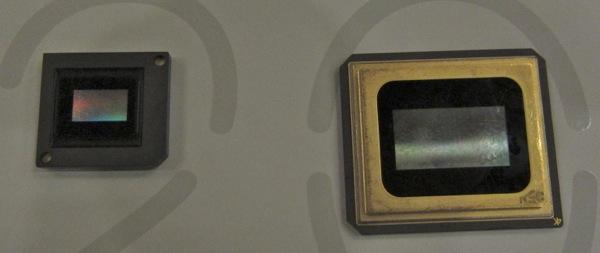New DLP Tech Delivers Wow Experience

The chip at the right in the photo is TI's big 4K DLP chip, widely used in 3-chip theater projectors. On the left is a new, smaller "4K" chip (though not quite true 4K, as I'll explain shortly). Its reduced size makes it possible to produce in the sort of quantities that can make 4K home theater DLP projectors relatively affordable.
What do I mean by not quite true 4K? Like JVC's and Epson's LCOS designs, a single chip DLP projector using this new chip will also use a form of pixel shifting to take a 4K source and display it on a chip of smaller resolution. In JVC's case the imaging chips (as an LCOS design it uses three of them, one each for fred, green, and blue) are 1080p, or roughly 2 million pixels. So the 8 million 4K source pixels are displayed on a chip with 2 million pixels, using pixel shifting to make the best use it can of the 8 million pixels in the source.
The new TI DLP chip works similarly, but it has 4 million pixels on its chip, so the "wobulation," or pixel shifting if you will, puts twice the number of native pixels on the screen as JVC does. Both use pixel shifting, but to use an analogy that's imprecise in this application but easy to grasp, the Ti chip produces only half as much "compression" of the 8 million source pixels as the JVC does.
TI set up a comparison of a prototype (single chip) projector using this new chip against a Sony true 4K projector (their least expensive model from last year). Also included in the comparison were a JVC pixel-shifting model (again, last year's) and Epson's laser-lit design that also uses pixel shifting. The source materials were all 4K.
With stationary test patterns it was no contest. All three of these LCOS/LCD designs showed serious artifacts and/or discolorations on all of the patterns, whereas the TI showed none. To be fair, the sort of artifacts and color shifts seen on these patterns are generally never visible on moving images in real-world source material; we've tested these or similar LCOS and LCD designs and don't see them. But technically the TI was superior.
In addition, the single chip DLP displayed markedly better resolution than any of the other models, all of which must rely on three accurately converged red, green, and blue chips to produce an image. One could argue, in fact, that even a subtle misalignment of the three chips could destroy any advantages available in a 4K source (misalignments that aren't possible in flat screen sets with its physically locked-in pixels). This would also be true, of course, of a three chip DLP.
We then moved on to a shorter 4K demo of moving images, pitting the DLP against only the JVC because of time limitations. Again, the DLP looked markedly superior, particularly in resolution. How much these differences resulted from the new single chip design and how much from differences in optics between the two projectors could not be determined.
While it's unlikely that the LCD triumvirate of manufacturers will abandon their painstakingly developed technology, other makers may jump into the breach and use this new chip makers such as Digital Projection, Christie, Barco, SIM 2, and Vivitek. In fact this new development might create an opening for a few additional competitors, perhaps among the companies who once produced impressive single chip designs and later abandoned them (talking to you Sharp, Yamaha, Marantz, and Samsung!). The only question is can they produce them at a price competitive with LCD/LCOS designs, and without resurrecting the dreaded singled-chip DLP rainbow effects. Achieving the latter may mean the use of expensive LED or laser lighting that can operate much faster than a color wheel and render those rainbows invisible.













































